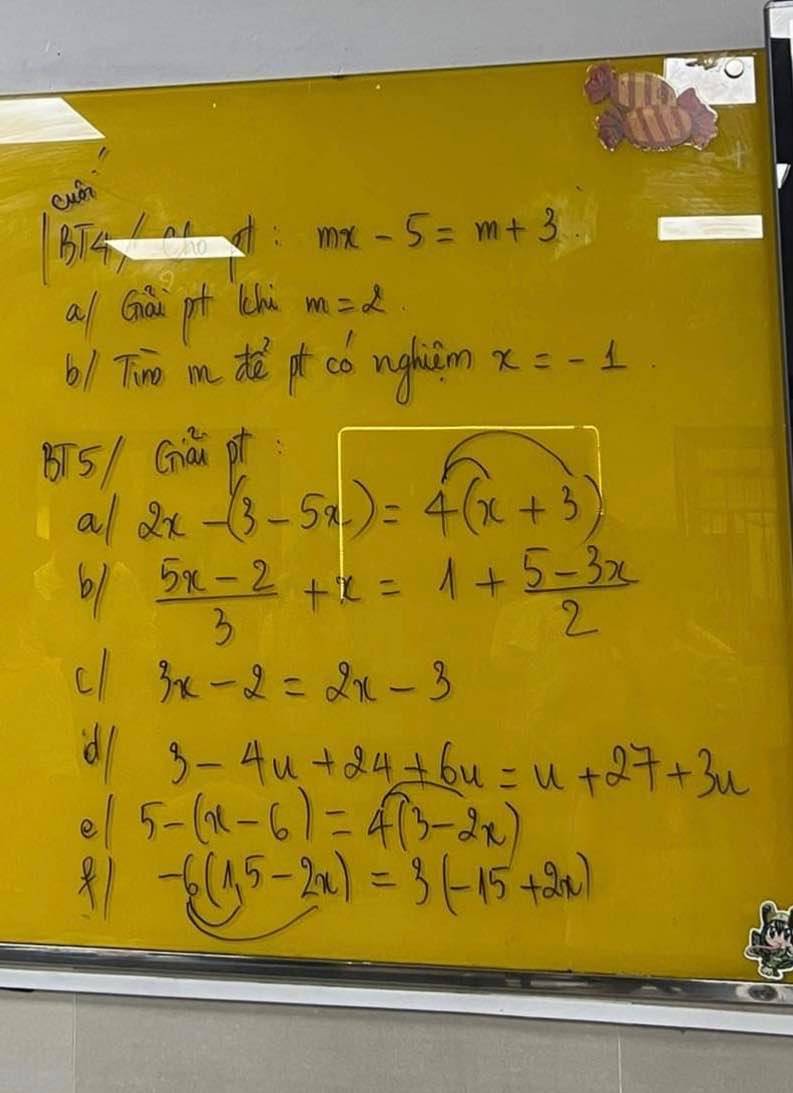
Hãy nhập câu hỏi của bạn vào đây, nếu là tài khoản VIP, bạn sẽ được ưu tiên trả lời.


Bài 2:
Xét ΔABC vuông tại A có \(BC^2=AB^2+AC^2\)
hay BC=10(cm)
Ta có: ΔABC vuông tại A
mà AM là đường trung tuyến
nên AM=BC/2=5(cm)

Phương trình bậc 3 thì chịu.
Mình bấm máy tính nó ra x=-3,256674079...
Sau khi giải thì nó ra x3-6x+15=0
Mình dùng phương pháp hệ số bất định để phân tích đa thức thành nhân tử nhưng số xấu lắm, mình cũng không biết có đúng không.

Bài 5:
a: 2x-(3-5x)=4(x+3)
=>2x-3+5x=4x+12
=>7x-3=4x+12
=>3x=15
=>x=5
b: =>5/3x-2/3+x=1+5/2-3/2x
=>25/6x=25/6
=>x=1
c: 3x-2=2x-3
=>3x-2x=-3+2
=>x=-1
d: =>2u+27=4u+27
=>u=0
e: =>5-x+6=12-8x
=>-x+11=12-8x
=>7x=1
=>x=1/7
f: =>-90+12x=-45+6x
=>12x-90=6x-45
=>6x-45=0
=>x=9/2


\(-2x^2-3x+5,875=-2\left(x^2+1.5x-2,9375\right)\)
\(=-2\left(x^2+1.5x+2,25-5,1875\right)\)
\(=-2\left[\left(x+1,5\right)^2-5,1875\right]\)
\(=-2\left(x+1,5\right)^2+10,375\)
Ta có: \(\left(x+1,5\right)^2\ge0\forall x\inℝ\)
\(\Rightarrow-2\left(x+1,5\right)^2\le0\forall x\inℝ\)
\(\Rightarrow-2\left(x+1,5\right)^2+10,375\le10,375\forall x\inℝ\)
(Dấu "="\(\Leftrightarrow x+1,5=0\Leftrightarrow x=-1,5\))
Vậy GTLN của \(-2x^2-3x+5,875\)là 10,375\(\Leftrightarrow x=-1,5\)
Sửa)):
Từ dòng 2
\(=-2\left(x^2+1,5x+0,5625-6,4375\right)\)
\(=-2\left(x+0,75\right)^2+12,875\le12,875\)

Lời giải:
a. $-8x+16+x^2=x^2-2.x.4+4^2=(x-4)^2$
b. $xy^2+\frac{1}{4}x^2y^4+1=(\frac{1}{2}xy^2)^2+2.\frac{1}{2}xy^2.1+1^2$
$=(\frac{1}{2}xy^2+1)^2$
a: \(x^2-8x+16=\left(x-4\right)^2\)
b: \(\dfrac{1}{4}x^2y^4+xy^2+1=\left(\dfrac{1}{2}xy^2+1\right)^2\)

số dư của phép chia 9 x 10 + 18 cho 27 là:
(9x10+18) : 27 = 4 (dư 0)
thì số dư của phép chia 9x10n+18 cho 27 cũng là 0
k cho mình nha bạn
Ta có : \(9.10^n+18=9.10^n+9.2\)\(=9.\left(10^n+2\right)\)\(⋮27\)
\(\Rightarrow\left(10^n+2\right)⋮3\) ma \(\left(10^n+2\right)⋮3\)
\(\Rightarrow9.10^n+18⋮27\)

\(\left(x+2\right)^2=\left(2x-1\right)^2\\ \Leftrightarrow\left(x+2\right)^2-\left(2x-1\right)^2=0\\\Leftrightarrow\left[x+2-\left(2x-1\right)\right]\left[x+2+2x-1\right]=0\\ \Leftrightarrow\left(x+2-2x+1\right)\left(x+2+2x-1\right)=0\\ \Leftrightarrow\left(-x+3\right)\left(3x+1\right)=0\\ \Leftrightarrow\left[{}\begin{matrix}-x+3=0\\3x+1=0\end{matrix}\right.\\ \Leftrightarrow\left[{}\begin{matrix}-x=-3\\3x=-1\end{matrix}\right.\\ \Leftrightarrow\left[{}\begin{matrix}x=3\\x=-\dfrac{1}{3}\end{matrix}\right.\)
\(\left(x+2\right)^2=\left(2x-1\right)^2\)
\(\Leftrightarrow\left[{}\begin{matrix}x+2=2x-1\\x+2=-\left(2x-1\right)\end{matrix}\right.\)
\(\Leftrightarrow\left[{}\begin{matrix}x-2x=-1-2\\x+2=-2x+1\end{matrix}\right.\)
\(\Leftrightarrow\left[{}\begin{matrix}-x=-3\\x+2x=1-2\end{matrix}\right.\)
\(\Leftrightarrow\left[{}\begin{matrix}x=3\\3x=-1\end{matrix}\right.\)
\(\Leftrightarrow\left[{}\begin{matrix}x=3\\x=-\dfrac{1}{3}\end{matrix}\right.\)





